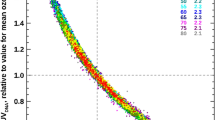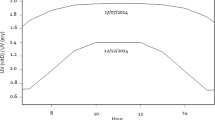Abstract
The solar irradiances for the initiation of vitamin D synthesis (UVD3) have been measured concurrently with the amount of cloud cover to investigate the influence of high cloud cover fraction. The cases of 6.5 and more octa cloud cover were considered for five solar zenith angle (SZA) ranges up to 80°. For each of the SZA ranges, the UVD3 reduced due to the high cloud cover. The average of the ratios of the UVD3 irradiances on a cloudy day to those on a clear day with the corresponding ozone and SZA are 0.71 for the 6.5–7.5 octa cloud and 0.45 for the more than 7.5 octa cloud ranges. The exposure times necessary to receive 1/3 MED to a horizontal plane were found to increase as the amount of cloud cover increased. For each cloud cover category, the range of values increased with cloud cover and with SZA. This research shows that the current public recommendations on the times of solar UV exposures required to produce adequate vitamin D are inappropriate for situations of more than 6.5 octa cloud.
Similar content being viewed by others
References
M. F. Holick, Sunlight and vitamin D for bone health and prevention of autoimmune diseases, cancers, and cardiovascular disease, Am. J. Clin. Nutr., 2004, 80, S1678–S1688.
CIE (International Commission on Illumination) Action spectrum for the production of pre-vitamin D3 in human skin, 2006, CIE 174: 2006.
M. F. Holick, Photobiology of Vitamin D, in Vitamin D, ed. D. Feldman, F. H. Glorieux and J. W. Pike, Academic Press, San Diego, 1997, pp. 33–39.
E. M. John, D. M. Dreon, J. Koo and G. G. Schwartz, Residential sunlight exposure is associated with a decreased risk of prostrate cancer, J. Steroid Biochem. Mol. Biol., 2004, 89–90, 549–552.
P. Tuohimaa, T. Keisala, A. Minasyan, J. Cachat and A. Kalueff, Vitamin D, nervous system and aging, Psychoneuroendocrinology, 2010, 345, S278–S286.
R. M. Lucas, A.-L. Ponsonby, Ultraviolet radiation and health: friend and foe, Med. J. Aust., 2002, 177, 594–598.
CIE (International Commission on Illumination) Recommendations on minimum levels of solar UV exposure, 2011, CIE 201: 2011.
Cancer Council, 2012, How much sun is enough? http://www.sunsmart.com.au/vitamin_d/how_much_sun_is_enough accessed Mar 2012.
M. F. Holick, L. Y. Matsuoka and J. Wortsman, Age, vitamin D, and solar ultraviolet, Lancet, 1989, 2, 1104–1105.
C. A. Nowson, T. H. Diamond, J. A. Pasco, R. S. Mason, P. N. Sambrook and J. A. Eisman, Vitamin D in Australia, Med. J. Aust., 2004, 177, 149–152.
A. R. Webb and O. Engelsen, Calculated ultraviolet exposure levels for a healthy vitamin D status, Photochem. Photobiol., 2006, 82, 1697–1703.
CIE (International Commission on Illumination), Erythema reference action spectrum and standard erythema dose, CIE S007E-1998, CIE Central Bureau, Vienna, Austria.
A. R. Webb, R. Kift, J. L. Berry and L. E. Rhodes, The vitamin D debate: translating controlled experiments into reality for human sun exposure times, Photochem. Photobiol., 2010, 87, 741–745.
D. J. Turnbull and A. V. Parisi, Latitudinal variations over Australia of the solar UV exposures for vitamin D3 in shade compared to full sun, Radiat. Res., 2010, 173, 373–379.
A. J. Samanek, E. J. Croager, P. Gies, E. Milne, R. Prince, A. J. McMichael, R. M. Lucas and T. Slevin, Estimates of beneficial and harmful sun exposure times during the year for major Australian population centres, Med. J. Aust., 2006, 184, 338–341.
A. J. Samanek, E. J. Croager, P. Gies, E. Milne, R. Prince, A. J. McMichael, R. M. Lucas and T. Slevin, Estimates of beneficial and harmful sun exposure times during the year for major Australian population cities, Med. J. Aust., 2006, 184, 338–341.
A. R. Webb, Who, what, where and when–influences on cutaneous vitamin D synthesis, Progress Biophys. Mol. Biol., 2006, 92, 17–25.
O. Engelsen, M. Brustad, L. Aksnes and E. Lund, Daily duration of vitamin D synthesis in human skin with relation to latitude, total ozone, altitude, ground cover, aerosols and cloud thickness, Photochem. Photobiol., 2005, 81, 1287–1290.
A. V. Parisi, D. J. Turnbull and J. Turner, Influence of clouds on pre-vitamin D3 effective solar UV exposures, Environ. Health, 2007, 7, 75–83.
M. Aun, K. Eerme, I. Ansko, U. Veismann and S. Latt, Modification of spectral ultraviolet doses by different types of overcast cloudiness and atmospheric aerosol, Photochem. Photobiol., 2011, 87, 461–469.
D. M. Villan, A. Castrillo and J. B. Santos, Empirical models of UV total radiation and cloud effect study, Int. J. Climatol., 2010, 30, 1407–1415.
A. V. Parisi and N. J. Downs, Cloud cover and horizontal plane eye damaging solar UV exposures, Int. J. Biomet., 2004, 49, 130–136.
J. Sabburg and C. N. Long, Improved sky imaging for studies of enhanced UV irradiance, Atmos. Chem. Phys., 2004, 4, 2543–2552.
WMO, Guide to Meteorological Instruments and Methods of ObservationWorld Meteorological Organisation, WMO No. 8, 5th edn, 1983, ch. 11: 11.2.
A. V. Parisi, D. J. Turnbull and J. Turner, Calculation of cloud modification factors for the horizontal plane eye damaging ultraviolet radiation, Atmos. Res., 2007, 86, 278–285.
D. Lubin and J. E. Frederick, The ultraviolet radiation environment of the Antarctic Peninsula: the roles of ozone and cloud cover, J. Appl. Meteorol., 1991, 30, 478–493.
G. R. Casale, A. M. Siani, H. Diemoz, M. G. Kimlin and A. Colosimo, Applicability of the polysulphone horizontal calibration to differently inclined dosimeters, Photochem. Photobiol., 2012, 88, 207–214.
R. L. McKenzie, J. B. Liley and L. O. Bjorn, UV radiation: balancing risks and benefits, Photochem. Photobiol., 2009, 85, 88–98.
O. Engelsen, The relationship between ultraviolet radiation exposure and vitamin D status, Nutrients, 2010, 2, 482–495.
Author information
Authors and Affiliations
Corresponding author
Additional information
Contribution to the Vitamin D update collected papers.
Rights and permissions
About this article
Cite this article
Parisi, A.V., Turnbull, D.J. & Downs, N.J. Influence of high levels of cloud cover on vitamin D effective and erythemal solar UV irradiances. Photochem Photobiol Sci 11, 1855–1859 (2012). https://doi.org/10.1039/c2pp25160d
Received:
Accepted:
Published:
Issue Date:
DOI: https://doi.org/10.1039/c2pp25160d




